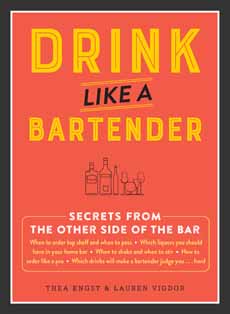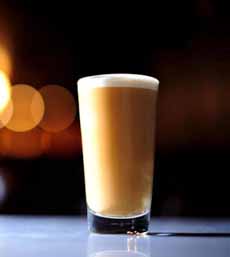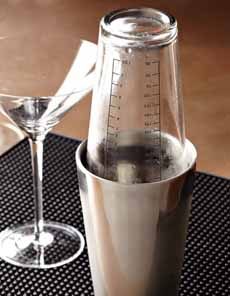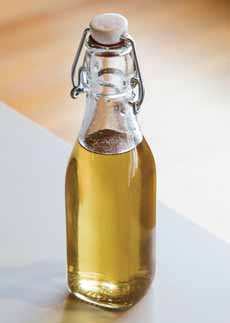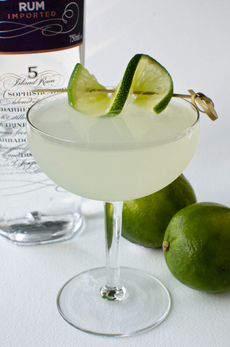TIP OF THE DAY: Home Cocktail Tips From Professional Bartenders
|
[1] Make better cocktails at home, and order better at bars. Get the book at Amazon.com.
[4] A channel knife makes peel and twist garnishes (available from Barconic). |
Our Tip Of The Day is from Thea Engst and Lauren Vigdor, authors of Drink Like A Bartender: Secrets From The Other Side Of The Bar. While there is much great information on how to order in a bar, here are their tips for home mixologists: Today we have the luxury of mixing bitters, fresh juices, and well-crafted liqueurs and spirits to make balanced beauties we can be proud of. We’ve come a long way from shutting our eyes and chugging moonshine for a buzz—our forefathers would be proud. A few years ago, Thea visited her Nana’s house for Christmas. Like a lady, she arrived with nothing but a bottle of bourbon. Her Nana was downsizing and trying to clean out her fridge, so she told Thea to make whatever she wanted with whatever she could find. Thea accepted Nana’s challenge. She found, among other things, a bottle of crème de menthe, heavy cream, and a few eggs. Along with the bourbon brought from home, Thea mixed the heavy cream, an entire egg, and a touch of the crème de menthe (warning: it’s a potent taste!) to make minty bourbon flips for her family (photo #2). To be fair, they were all hesitant as they watched her throw an entire egg in the shaker, but they were happy with the result. What’s the moral of this story? Don’t be afraid to experiment with what you’ve got! Nana’s liquor cabinet was limited, but she had a few essentials: eggs and cream. You don’t need a citrus or fancy mixers to make a delicious drink. You too can be like Thea and Lauren. Here are some tools to keep on hand for when it’s your moment to impress your friends and family: > Twist: When you use a channel knife to peel a narrow spiral of fruit skin. A twist is actually twisted citrus peel, or, a long narrow rope of the peel only that is twisted into a corkscrew shape. > Hawthorne Strainer (photo #3): The strainer with the coils. It essentially looks like it has a slinky on it. This is a pretty universal strainer, so you can’t really go wrong with it. Some people want to get the ice chunks out of a shaken drink and will use the Hawthorne strainer as well as the tea strainer. That’s about preference. This is a good tool to get mint bits out of a drink, too! Pro Tips: |
|
|
THE GOOD STUFF Just like Ocean’s Eleven, when it comes to drink making, you have key characters doing things that are apparently important. We got the explosive expert, the tech person, the driver, and the dude who gets everyone together and somehow gets all the credit. Your home bar components are just like this. You need to have: |
||
|
MECHANICS Let’s talk about the birds and the bees of bartending: shaking and stirring. You are building a cocktail—let’s say it’s a Daiquiri. The rum, simple syrup, and lime go in the little guy shaker (the smaller half of your shaker). Then you take a scoop of ice with the big boy shaker (the bigger half of your shaker), throw the ice into the little shaker, and lock the big shaker into the little shaker. Remember that you don’t want them to be directly up and down. The two sides won’t seal effectively that way. Make them crooked: The rim of the big half should be touching the side of the little half in one spot. Then smack the top with the heel of your hand until it locks. You are going to be throwing this bad boy around a little, after all. A poorly sealed shaker will split during the shaking process and that’s a good way to get yourself sticky. Now to unlock the shaker: hold the locked shakers in one hand so that your palm lines up with where the two halves meet. Take the heel of your other hand and hit the opposite side of the sealed shakers. It should unlock with one to three steady hits. Done! Shaken Or Stirred? When you shake a cocktail, you incorporate a lot of air and small chips of ice into the drink. The shaking motion whips the cocktail (think of stirring a cup of cream versus making whipped cream) and breaks the ice down by knocking it into the sides of the shaker. When you stir a cocktail, the ice spins around in the center of your mixing glass as one continuous piece. It slowly melts into the drink to dilute it slightly, which softens and expands the flavors, and very little air is added. Stirring cocktails is what gives your Martinis and Manhattans that silky smooth mouthfeel, whereas shaking is what makes your margarita so dang frothy. We’ll get more into when to shake and when to stir later. Dry Shake Or Wet Shake? A dry shake is when you put all your ingredients into the shaker and shake them without ice. A wet shake is the opposite— it’s when all your ingredients are shaken with ice. So when do you use a dry shake and when do you use a wet shake? We’re glad you asked! You should use a dry shake when you are making a drink that is served over crushed ice. Do you remember what we said about dilution earlier—how shaking with ice dilutes the drink ever so slightly? Using a dry shake here helps from diluting a drink further (pouring it over crushed ice dilutes it as well). When you’re still getting a feel for how long to dry shake, it’s super-helpful to add just one cube to the shaker. When you can’t hear the cube shaking around anymore, it’s time to add more ice. What about stirring? You don’t have to worry so much about over-stirring cocktails. Unlike shaking, the ice isn’t chipping and melting quickly in the process. Still, you don’t want to overstir. A good number of stirs to aim for is 40–50 turns. Pro Tip: Mixers Alas, we don’t have the room to print them today. You’ll just have to read the book! |
 [5] Julep strainer, available from Bar Products.
[8] A classic Daiquiri, invented by American engineers in Cuba. Here’s the scoop (photo courtesy Bacardi). Also: Yuzu Daiquiri recipe and Grapefruit Daiquiri, both delicious. |
|
|
|
||
